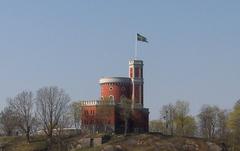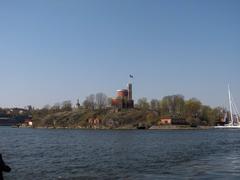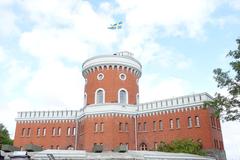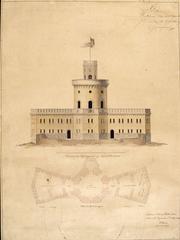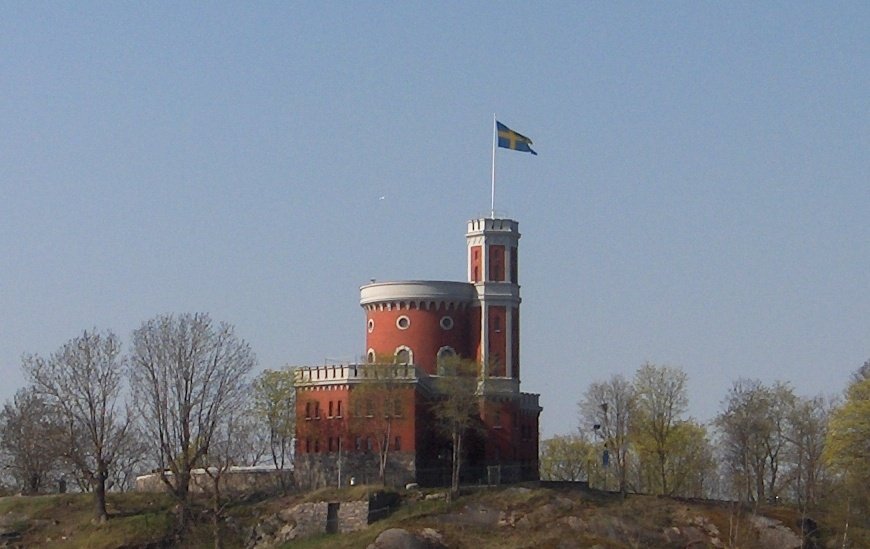
Kastellet Stockholm: Visiting Hours, Tickets, and Historical Significance Guide
Date: 14/06/2025
Introduction
Kastellet Stockholm, perched on the tranquil islet of Kastellholmen in the city’s heart, is one of Sweden’s most distinguished historical landmarks. Originally constructed in 1667 and rebuilt in the neo-Gothic style in the mid-19th century, Kastellet has served as a strategic military outpost, a ceremonial beacon, and now a beloved cultural venue. Its prominent red-brick tower and the daily ritual of raising the Swedish Military Ensign make it a symbol of national pride and a living testament to Stockholm’s maritime heritage. As a visitor, you will find not only a window into Sweden’s military history but also panoramic city views, serene parkland, and integration with Stockholm’s vibrant urban and cultural scene.
This comprehensive guide details Kastellet’s rich history, architectural highlights, current visiting hours, ticketing information, accessibility, travel tips, and nearby attractions. Whether you’re a history buff, architecture enthusiast, or traveler seeking authentic Stockholm experiences, Kastellet deserves a prominent place on your itinerary.
For the latest details, refer to the Kastellet Museum website and the Kastellet Stockholm official site (military-history.fandom.com; viewstockholm.com; totraveltoo.com).
Table of Contents
- Introduction
- Historical Overview
- Architectural and Military Features
- Ceremonial and Cultural Significance
- Kastellet’s Place in Stockholm’s Defenses
- Contemporary Uses and Preservation
- Visitor Information
- Frequently Asked Questions (FAQ)
- Visual Highlights and Photography
- Conclusion
- References
Historical Overview
Early Fortifications and Strategic Role
Kastellet’s story begins in 1667, when military engineer Erik Dahlbergh designed the original fortress to safeguard Stockholm’s key maritime approaches. As Sweden emerged as a European power, the fortress was a linchpin in the city’s defensive network, supporting the broader archipelago system against rivals like Denmark and Russia (military-history.fandom.com; totraveltoo.com). Its placement on Kastellholmen provided commanding views and control over vital waterways.
Destruction and Neo-Gothic Reconstruction
After nearly two centuries of service, the original structure was destroyed by an explosion in 1845, likely caused by an ammunition accident. Renowned architect Fredrik Blom led the rapid reconstruction from 1846–1848, designing the current round red-brick tower with a 20-meter stair turret, which stands as a distinct architectural feature in Stockholm’s skyline (military-history.fandom.com; viewstockholm.com).
Architectural and Military Features
Kastellet’s neo-Gothic style—marked by crenellated parapets, robust brickwork, and a prominent stair tower—was both aesthetically striking and militarily functional. The elevated tower provided strategic surveillance and firing positions, while the fortress’s compact size and thick walls allowed it to serve as both a deterrent and a defensive stronghold (Statens fastighetsverk).
Ceremonial and Cultural Significance
Beyond its military past, Kastellet is a powerful symbol of Swedish sovereignty. The Swedish Military Ensign is ceremonially hoisted and lowered daily, a tradition dating back centuries. Notably, in 1996, Norwegian expatriates raised their national flag here on Norway’s Constitution Day, reinforcing Kastellet’s diplomatic and cultural role (military-history.fandom.com; viewstockholm.com).
Kastellet’s Place in Stockholm’s Defenses
Kastellet was an integral part of a fortified network including Vaxholm Citadel and Siarö Fortress, serving as a forward artillery post and an early warning station. This system protected Stockholm’s approaches and underscored the city’s maritime importance (totraveltoo.com). Though decommissioned as a military site, Kastellet remains a symbol of defense heritage.
Contemporary Uses and Preservation
Since the 1970s, Kastellet has transitioned to civilian use. It now houses event and conference spaces, is home to the Swedish Naval Officers’ Society, and regularly hosts ceremonies and cultural events. As a state-protected building since 1935, ongoing restoration ensures it remains a vibrant part of Stockholm’s urban landscape (Statens fastighetsverk; Kastellet Stockholm).
Visitor Information
Visiting Hours & Tickets
- Outdoor Areas: Open to the public year-round, 24/7.
- Interior Access: Generally limited; available only for pre-booked events, conferences, or group visits.
- Guided Tours: No regular public guided tours; check for special event openings.
- Tickets: No tickets required for outdoor areas; interior/event access by prior arrangement (Evendo).
Getting There
- On Foot: Walk from central Stockholm, crossing Skeppsholmen to Kastellholmen via bridges.
- Public Transport: Metro to Kungsträdgården or Östermalmstorg, then a 10–15 minute walk along the waterfront.
- By Car: Limited parking nearby; public transport is recommended.
- By Ferry: Ferries serve central Stockholm; from the pier, walk or use local buses (Evendo).
Accessibility
- Grounds: Generally accessible for wheelchairs and strollers.
- Interiors: Limited accessibility due to historic design; contact venue for specifics.
- Restrooms: Primarily available to event guests; public facilities may be limited.
Facilities & Practical Tips
- Event Spaces: Several rooms available for hire (e.g., Krutrummet, Gunrummet, Kolskjulet).
- Picnic Areas: Benches and lawns for relaxation; no permanent café, so bring refreshments.
- Pets: Dogs on leashes allowed; check for restrictions during events.
- Safety: Supervise children near the water and historic structures; respect site rules.
Nearby Attractions
- Vasa Museum: Home to a 17th-century warship.
- Royal Palace: The official residence of the Swedish monarch.
- Moderna Museet: Modern art museum on neighboring Skeppsholmen.
- Gamla Stan: Stockholm’s medieval Old Town (Nomadic Matt).
Frequently Asked Questions (FAQ)
Q: What are Kastellet’s visiting hours?
A: Outdoor grounds are open year-round without fixed hours; interior access by event or arrangement only.
Q: Do I need a ticket to visit Kastellet?
A: No tickets are needed for outdoor areas; interior/event visits require booking.
Q: Is Kastellet accessible for people with disabilities?
A: Outdoor paths are accessible; interior access may be limited—contact the venue in advance.
Q: Are guided tours available?
A: No regular public tours, but special events may offer access.
Q: Can I bring my dog?
A: Yes, leashed dogs are allowed on the grounds.
Visual Highlights and Photography
Kastellet’s elevated location offers exceptional panoramic views of Stockholm’s cityscape and waterways. The iconic red-brick tower is especially photogenic during sunrise and sunset. Capture the daily flag ceremony or enjoy tranquil scenes of the harbor. For virtual previews, consult Stockholm’s official tourism sites.
Conclusion
Kastellet Stockholm is more than a fortress; it is a living monument to Sweden’s military heritage, architectural ingenuity, and civic pride. While interior access is mostly reserved for private functions, the fortress grounds and surrounding parkland provide a peaceful and historically rich haven in the heart of the city. With its easy accessibility, proximity to major attractions, and breathtaking views, Kastellet is a must-visit for anyone exploring Stockholm.
For up-to-date information on events, bookings, or any changes to visiting hours, always check the official Kastellet Stockholm website.
References
- military-history.fandom.com
- viewstockholm.com
- totraveltoo.com
- Wikipedia
- Statens fastighetsverk
- Kastellet Stockholm
- Kastellet Museum
- Evendo
- Nomadic Matt
